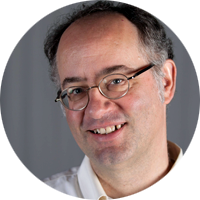
Photo by David Fine
Atlanta Fed research economist Nikolay Gospodinov is a highly sophisticated mechanic, in a sense.
Rather than machines, he works on economic models. His work is essentially a sustained campaign to make these basic tools of economists as sturdy and reliable as possible.
Many economists prize their models, but the premise of Gospodinov's work is that all models are "misspecified." That means they are imperfect, he says—"crude approximations of a complex reality." An economic model is a theoretical construct meant to represent reality. Feed in some data, and the model's results tell you how something happened or what might happen in the real world under a certain set of economic circumstances.
Gospodinov explores model uncertainty, the ways in which economic models fall short. A common underlying flaw is their lack of resilience to small changes in the incoming data. Gospodinov believes that model and data uncertainty need to be confronted rather than brushed aside.
Put simply, Gospodinov dissects models in a quest to make these inherently imperfect tools less imperfect. His research suggests that the best approach in trying to map complex processes—which often hinge on highly uncertain ingredients—is to incorporate lots of models rather than relying on a single, even very good, one.
"Even if you choose the least imperfect model, that means you're ignoring information from all the other ones," says Gospodinov, a Bulgarian native who was more a soccer player than a math whiz as a kid. "So we are constructing an aggregated model."
Pushing the frontiers
Gospodinov's early models study large movements in the prices of assets such as stocks, bonds, and other financial holdings. But this approach could also examine other aspects of finance or economics, he says.
Crucial to employing such an aggregated model, Gospodinov notes, is realizing that it too is ultimately fallible. So he tries to determine where the imperfections lie in the combination of models and then feeds that information back into his aggregated model to refine it.
Yet the gaps are actually narrow between the products of traditional models and those of Gospodinov's amalgam of models. Rather than fundamental differences, they are "small variations close to the frontier of knowledge," he explains.
Still, those variations matter. The goal of econometricians like Gospodinov, after all, is not to poke holes in someone else's research. It is about equipping policymakers, researchers, and investors with sharper instruments that help them minimize mistakes and thus make the financial system and economy safer and more stable.
Only in recent years have econometricians—economists like Gospodinov who specialize in advanced statistical analysis—begun seriously examining the uncertainty of models. It helps that researchers today have ever-expanding troves of data and exponentially increasing computing power at their disposal.
"Nikolay is working on cutting-edge research," said Scott Frame, a financial economist at the Atlanta Fed who has worked extensively on mortgage finance issues.
The intellectual challenge
Gospodinov says intellectual curiosity draws him to the sometimes arcane discipline of financial economics. "It's all about the research," he said.
As a professor for 13 years before joining the Atlanta Fed, he honed his approach to decoding complicated financial market puzzles. Gospodinov came to the Fed to broaden his research agenda free from teaching duties. And, not insignificantly, he can contribute to monetary and economic policy formulation. He can also contribute to the stability and resilience of our financial system. Gospodinov has used his techniques to ensure the robustness of models used in stress tests the Fed administers to the nation's largest banks.
Distilled to its most basic form, the work of Gospodinov and his Atlanta Fed finance colleagues focuses on figuring out which forces, among thousands, are at work. For example, what makes stock values move one way and bonds the same or a different way? And how does macroeconomic performance affect those financial assets, at home and abroad? How and why does the fluctuation of asset values in one country affect values in another?
Gospodinov has recently written a working paper exploring such "co-movements" of assets. He also published recent work on building an aggregated model for pricing financial assets.
In search of obscure variables
The questions Gospodinov and other Fed economists pursue offer no easy answers. That complexity makes honing the models that much more critical, he said.
"It turns out that all the interesting variables to us as policymakers are unobservable," he said.
We know the unemployment and inflation rate. But what is the "natural unemployment rate"? What about the "equilibrium interest rate," the magic level at which the price of money neither stimulates nor impedes economic growth? Or the inflation risk premium, the price investors in long-term bonds pay based on what inflation is likely to be in the future?
Those questions don't come with settled answers. Yet those questions and their answers are critical ingredients in formulating monetary policy, Gospodinov explains.
To deepen understanding of these questions, Gospodinov and colleagues at the New York Fed are devising a tool that will measure the underlying state of the economy. A product of the aggregated-model approach, this gauge will estimate where we stand in the business cycle. It would, for instance, help to clarify whether the economic expansion—now eight-and-a-half years long—is nearing an end.
Gospodinov and his econometrician colleagues continually refine machines that will never be truly completed. The economy and financial markets constantly change, and so do the tools economists have available—and the tools they will require. "We're pushing the frontier as much as we can," Gospodinov says. "There's no end, right? And it's fun."




